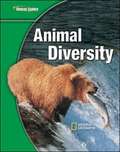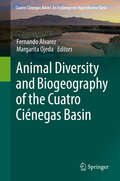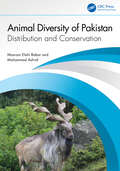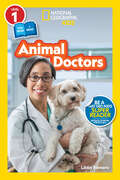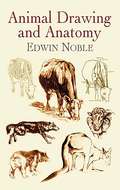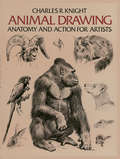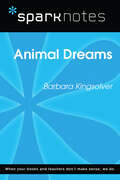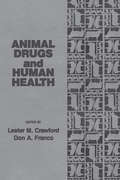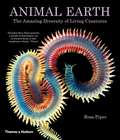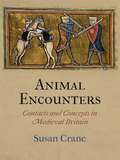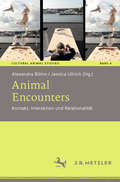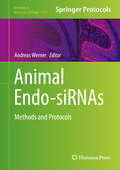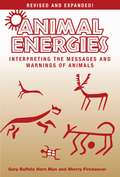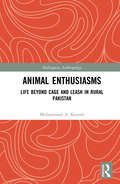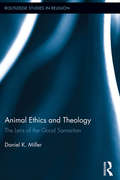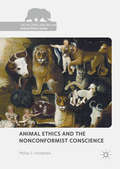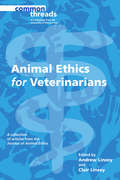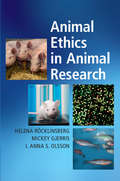- Table View
- List View
Animal Diversity
by Glencoe Mcgraw-HillDiscover the Flexibility to Teach Science Your Way!. "Glencoe Science: Animal Diversity," a module in the Glencoe Science 15 book series, provides students with accurate and comprehensive coverage of middle school National Science Education Standards. Concepts are explained in a clear, concise manner, and are integrated with a wide range of hands-on experiences, critical thinking opportunities, real-world applications, and connections to other sciences and to non-science areas of the curriculum. Co-authored by National Geographic, unparalleled graphics reinforce key concepts. A broad array of print and technology resources help differentiate and accommodate all learners. The modular approach allows you to mix and match books to meet your specific curriculum needs.
Animal Diversity and Biogeography of the Cuatro Ciénegas Basin (Cuatro Ciénegas Basin: An Endangered Hyperdiverse Oasis)
by Fernando Álvarez Margarita OjedaThis volume investigates the contemporary fauna that inhabit the Cuatro Ciénegas Basin. Divided into 15 chapters, it addresses and describes their diversity, taxonomic and biogeogaphic affinities, and ecological characteristics. The Cuatro Ciénegas Valley is a unique oasis in the south-central region of the State of Coahuila, part of the Sonoran Desert, in Mexico. Several clues, specially derived from the study of the microbiota, suggest a very ancient origin of the valley and its permanence through time. This condition had promoted a high level of endemism and led to unique interactions between the resident species.
Animal Diversity of Pakistan: Distribution and Conservation
by Muhammad Ashraf Masroor Elahi BabarThis book presents principles of animal biodiversity, its importance, sustainable utilization, and conservation. The introductory chapter explores the origins and evolution of biodiversity throughout time, shedding light on the remarkable developments that have taken place over the ages. The subsequent chapters of the book reveal the tools and techniques used to assess the status of biodiversity at any given stage. The book meticulously details the indicators and measurement methods employed to gauge the health and vitality of biodiversity. Furthermore, it elucidates the vital role biodiversity plays in serving humanity and underscores the dire consequences that may ensue if we fail to preserve it. It also introduces the nomenclature of species and explores their intricate phylogenetic relationships with both living and non-living entities. The spatial and temporal distribution of animals, unraveling the fascinating patterns and dynamics that govern their presence across the globe, is also discussed in the book. Additionally, the book unveils a repertoire of conservation methods aimed at preserving existing biodiversity and ensuring its sustainable future. Toward the end, the book offers valuable suggestions and highlights untapped avenues for future research, all geared toward safeguarding the current level of biodiversity and ensuring its prosperity in the years to come. This book is a valuable source for students and professionals in the fields of biology, ecology, and conservation biology.
Animal Doctors (National Geographic Readers)
by Libby RomeroTHE VET IS IN! Join animal doctors as they care for cuddly pets and farm animals, rehabilitate cool wild animals, and rescue big sea life in this Level 1 Co-reader! Through this delightful beginning reader, youngsters and their grown-ups can follow veterinarians throughout their day as they care for sick and healthy animals, from house pets to zoo and ocean animals. Fans of Disney Junior’s hit television series Doc McStuffins will love this introduction to real-life animal doctors and rescues! Key features include: - Expert-vetted text appropriate for ages 4 to 6 - Beautiful and engaging photos - Fun approach to high-interest subject National Geographic Readers' exciting approach to reading, featuring expert-vetted text and fascinating images, has proved to be a winning formula with kids, parents, and educators. Each reader is written by a talented children's book author and includes a photo glossary and interactive features that reinforce what kids have learned in the book. National Geographic Readers feature engaging text carefully vetted by expert educators and accompanied by magnificent National Geographic photography. The Co-reader level provides a collaborative reading experience between an adult and child.
Animal Drawing and Anatomy
by Edwin Noble"No artist, designer, or craftsman can be regarded as fully equipped without a knowledge of natural forms," asserts this instructive volume. "All forms of life offer rich material for design, whether realistic or conventional," it notes, adding that studies from life "of the human figure, the forms of all animals and birds, and of the inhabitants of the waters, and of plants, must precede mastery of the art of design." With this profusely illustrated guide, beginners can learn the fundamentals of animal drawing, and more experienced artists can find tips that will assist them in refining their skills. Written and illustrated by a distinguished artist and art instructor of the early twentieth century, this volume features valuable insights into reproducing accurate images of horses, cows, dogs, sheep, birds, and wild animals. The explanatory text, highlighted by 233 drawings, offers advice not only on depicting musculature, hair, feathers, and other obvious physical features, but also on such essentials as action, pose, proportions, and character.
Animal Drawing: Anatomy and Action for Artists
by Charles KnightA master of animal portraiture presents an extensive course in creating lifelike drawings of a host of creatures: great apes, tigers, lions, dogs, bears, horses, crocodiles, snakes, fish, and many others. Subjects include animal musculature, bone structure, psychology, movements, habits, and habitats. Suitable for commercial and fine artists, painters, sculptors, and students. 123 illustrations.
Animal Dreams (SparkNotes Literature Guide Series)
by SparkNotesAnimal Dreams (SparkNotes Literature Guide) by Barbara Kingsolver Making the reading experience fun! Created by Harvard students for students everywhere, SparkNotes is a new breed of study guide: smarter, better, faster. Geared to what today's students need to know, SparkNotes provides: chapter-by-chapter analysis explanations of key themes, motifs, and symbols a review quiz and essay topics Lively and accessible, these guides are perfect for late-night studying and writing papers.
Animal Drugs and Human Health
by Lester M. Crawford Don A. FrancoThe presence of drug and chemical residues in food products from animal sources is both a public health problem and a consumer concern. This is the first book to examine and analyze this problem in a scientific, non-partisan way. The twelve contributing authors are all recognized authorities on this topics. An important resource for food scientists and analysts working with meat food products.
Animal Ears (Look Once Look Again Science Series)
by David SchwartzYoung scientists will examine plant parts and animal features "up close" and then turn the page to see how these smaller parts fit into the "bigger picture." Children will take a close-up view of the powerful ears of a bat, the thorny stem of a blackberry bush, the sticky tongue of a fly, and more.
Animal Earth: The Amazing Diversity of Living Creatures
by Ross Piper<P>What most think of as the animal kingdom―from elephants to amphibians―in fact accounts for only a tiny portion of the tens of millions of species that scientists speculate inhabit planet Earth. Animal Earth is an unbiased tour of this still largely undiscovered world, illuminating the bizarre appearances and hidden lives of the creatures that share our planet, but which we’ve rarely, if ever, seen. <P>What is perhaps more surprising is that this bewildering range of animal species can be traced to a small number of lineages, sharing a common body plan and evolutionary history. Animal Earth not only provides an evenhanded summary of each but also reflects the latest research on the evolutionary relationships between species. How they all fit in the tree of life is a topic that has been debated for decades, not least because new species are being discovered all the time; some lesser-known lineages, such as the Chaetognatha (arrow worms) and Xenoturbellida (strange worms) continue to defy classification. <P>Given our technological achievements, humans are in a uniquely privileged position to protect animal diversity. As Ross Piper makes clear, each species is an integral component of the ecosystem we live in, and we protect animal diversity not only for its own sake but to maintain the natural systems that keep us alive. 540 color illustrations</P>
Animal Eggs (Into Reading, Level B)
by Annette Smith<p>NIMAC-sourced textbook <p>Some animals' babies come out of an egg. Do you know which ones do? Read about it here!</p>
Animal Electricity: How We Learned That the Body and Brain Are Electric Machines
by Robert B. CampenotLike all cellular organisms humans run on electricity. Cells work like batteries: slight imbalances of electric charge across cell membranes, caused by ions moving in and out of cells, result in sensation, movement, awareness, and thinking--the things we associate with being alive. Robert Campenot offers an accessible overview of animal electricity.
Animal Encounters
by Susan CraneTraces of the living animal run across the entire corpus of medieval writing and reveal how pervasively animals mattered in medieval thought and practice. In fascinating scenes of cross-species encounters, a raven offers St. Cuthbert a lump of lard that waterproofs his visitors' boots for a whole year, a scholar finds inspiration for his studies in his cat's perfect focus on killing mice, and a dispossessed knight wins back his heritage only to give it up again in order to save the life of his warhorse. Readers have often taken such encounters to be merely figurative or fanciful, but Susan Crane discovers that these scenes of interaction are firmly grounded in the intimate cohabitation with animals that characterized every medieval milieu from palace to village. The animal encounters of medieval literature reveal their full meaning only when we recover the living animal's place within the written animal.The grip of a certain humanism was strong in medieval Britain, as it is today: the humanism that conceives animals in diametrical opposition to humankind. Yet medieval writing was far from univocal in this regard. Latin and vernacular works abound in other ways of thinking about animals that invite the saint, the scholar, and the knight to explore how bodies and minds interpenetrate across species lines. Crane brings these other ways of thinking to light in her readings of the beast fable, the hunting treatise, the saint's life, the bestiary, and other genres. Her substantial contribution to the field of animal studies investigates how animals and people interact in culture making, how conceiving the animal is integral to conceiving the human, and how cross-species encounters transform both their animal and their human participants.
Animal Encounters: Kontakt, Interaktion und Relationalität (Cultural Animal Studies #4)
by Alexandra Böhm Jessica UllrichDer Band bestimmt den Begriff der Begegnung als eigene, bedeutungstragende Kategorie und fokussiert zum ersten Mal systematisch und historisch Fragen der Interaktion zwischen Menschen und Tieren in Philosophie, Kunst, Literatur und in sozio-kulturellen Praktiken. Einzelanalysen untersuchen die Formen und Funktionen der Interaktion zwischen unterschiedlichen Spezies sowie deren grundlegende Muster, die einerseits von Empathie, Achtsamkeit oder Agency gekennzeichnet sind, bzw. andererseits von Gewalt, Ausgrenzung, Widerständigkeit oder Konfrontation. Damit ergänzt die Publikation die Erforschung der Tier-Mensch-Beziehung um den zentralen Aspekt von ambivalenten Interspezies-Begegnungen, die zugleich destruktives und transformatives Potential offenbaren.
Animal Endo-SiRNAs: Methods and Protocols (Methods in Molecular Biology #1173)
by Andreas WernerAnimal Endo-SiRNAs: Methods and Protocols presents a variety of approaches to investigate endo-siRNAs. These include protocols applicable to study short RNAs expressed at a low level and model systems that are particularly suitable to investigate specific aspects of endo-siRNAs, their synthesis, their genomics or regulatory role. Written in the highly successful Methods in Molecular Biology series format, chapters include introductions to their respective topics, lists of the necessary materials and reagents, step-by-step, readily reproducible laboratory protocols and tips on troubleshooting and avoiding known pitfalls. Authoritative and practical, Animal Endo-SiRNAs: Methods and Protocols contains practical tips that are absent in standard lab manuals. "
Animal Energies: Interpreting the Messages and Warnings of Animals
by Gary Buffalo Horn Man Sherry FiredancerFind life guidance from the powerful ancient knowledge of animals.In many Native American traditions, animals are considered to be our older, wiser brothers and sisters. Their behavior can help us better understand ourselves, heal old wounds, adapt to new situations, or warn us of dangers. Animal Energies shows us how to interpret our physical and spiritual encounters with animals in ways that enable us to achieve balance in the natural world.Colorfully illustrated and easy-to-reference, the book presents little-known facts about the habits of fifty-eight North American animals, including their strengths and vulnerabilities. By using these ancient animal energies, we are guided gently through life's challenges and obstacles. We may soar with the eagle and run with the wolves, yet even the earthworm has something to teach us.This updated edition of Dancing Otters and Clever Coyotes includes more personal animal encounters and an updated foreword from the authors. Join them as they share what they've learned from Native American elders and from their own personal journeys, reminding readers of the inherent bond that humans have with all things in nature.
Animal Enthusiasms: Life Beyond Cage and Leash in Rural Pakistan (Multispecies Anthropology)
by Muhammad A. KaveshAnimal Enthusiasms explores how human–animal relationships are conceived, developed, and carried out in rural Pakistani Muslim society through an examination of practices such as pigeon flying, cockfighting, and dogfighting. Based on two years of ethnographic fieldwork carried between 2008 and 2018 in rural South Punjab, the book examines the crucial cultural concept of shauq (enthusiasm) and provides critical insight into changing ways of life in contemporary Pakistan. It tracks the relationships between men mediated by non-human animals and discusses how such relationships in rural areas are coded in complex ways. The chapters draw on debates around transformations of animal activities over time, the changing forms of human–animal intimacy and their impact on familial relationships, and rural Punjabi values attached to the performance of masculine honour. The book will be of interest to scholars of anthropology, multi-species ethnography, gender and masculinity studies, and South Asian studies.
Animal Ethics and Theology: The Lens of the Good Samaritan (Routledge Studies in Religion)
by Daniel MillerIn this book, Daniel K. Miller articulates a new vision of human and animal relationships based on the foundational love ethic within Christianity. Framed around Jesus’ parable of the Good Samaritan, Animal Ethics and Theology thoughtfully examines the shortcomings of utilitarian and rights-based approaches to animal ethics. By considering the question of animals within the Christian concept of neighbourly love, Miller provides an alternative narrative for understanding the complex relationships that humans have with other animals. This book addresses significant theological questions such as: Does being created in the image of God present a meaningful distinction between humans and other animals? What does it mean for humans to have dominion (Gen. 1:28) over animals? Is meat eating a moral problem for Christians? In addition to drawing out the significance of Christian theology for field of animal ethics this book also engages environmental and feminist ethics. Miller brings a theological perspective to such questions as: Should care for animals be distinguished from care for the environment, and what role should human emotions play in our ethical dealings with other animals? As the title suggests, this book provides fresh insight into the theological significance of human relationships with other animals.
Animal Ethics and the Autonomous Animal Self (The Palgrave Macmillan Animal Ethics Series)
by Natalie ThomasThis book presents a radical and intuitive argument against the notion that intentional action, agency and autonomy are features belonging only to humans. Using evidence from research into the minds of non-human animals, it explores the ways in which animals can be understood as individuals who are aware of themselves, and the consequent basis of our moral obligations towards them. The first part of this book argues for a conception of agency in animals that admits to degrees among individuals and across species. It explores self-awareness and its various levels of complexity which depend on an animals’ other mental capacities. The author offers an overview of some established theories in animal ethics including those of Peter Singer, Tom Regan, Bernard Rollin and Lori Gruen, and the ways these theories serve to extend moral consideration towards animals based on various capacities that both animals and humans have in common. The book concludes by challenging traditional Kantian notions of rationality and what it means to be an autonomous individual, and discussing the problems that still remain in the study of animal ethics.
Animal Ethics and the Nonconformist Conscience (The Palgrave Macmillan Animal Ethics Series)
by Philip J. SampsonThis book explores the religious language of Nonconformity used in ethical debates about animals. It uncovers a rich stream of innovative discourse from the Puritans of the seventeenth century, through the Clapham Sect and Evangelical Revival, to the nineteenth century debates about vivisection. This discourse contributed to law reform and the foundation of the RSPCA, and continues to flavour the way we talk about animal welfare and animal rights today. Shaped by the "nonconformist conscience", it has been largely overlooked. The more common perception is that Christian “dominion” authorises the human exploitation of animals, while Enlightenment humanism and Darwinian thought are seen as drawing humans and animals together in one "family". This book challenges that perception, and proposes an alternative perspective. Through exploring the shaping of animal advocacy discourses by Biblical themes of creation, fall and restoration, this book reveals the continuing importance of the nonconformist conscience as a source to enrich animal ethics today. It will appeal to the animal studies community, theologians and early modern historians.
Animal Ethics for Veterinarians (Common Threads)
by Andrew Linzey Clair LinzeyVeterinarians serve on the front lines working to prevent animal suffering and abuse. For centuries, their compassion and expertise have improved the quality of life and death for animals in their care. However, modern interest in animal rights has led more and more people to ask questions about the ethical considerations that lie behind common veterinary practices. This Common Threads volume, drawn from articles originally published in the Journal of Animal Ethics (JAE), offers veterinarians and other interested readers a primer on key issues in the field. Essays in the first section discuss aspects of veterinary oaths, how advances in animal cognition science factor into current ethical debates, and the rise of complementary and alternative veterinary medicine and its relationship to traditional veterinary medicine. The second section continues with an essay that addresses why veterinarians have an obligation to educate animal caregivers to look past "cuteness" in order to treat all animals with dignity. The collection closes with three short sections focusing on animals in farming, trade, and research ”areas where veterinarians encounter conflicts between their job and their duty to advocate and care for animals. Contributors: Judith Benz-Schwarzburg, Vanessa Carli Bones, Grace Clement, Simon Coghlan, Priscilla N. Cohn, Mark J. Estren, Elisa Galgut, Eleonora Gullone, Matthew C. Halteman, Andrew Knight, Drew Leder, Andrew Linzey, Clair Linzey, Kay Peggs, Megan Schommer, Clifford Warwick, and James W. Yeates.
Animal Ethics in Animal Research
by Helena Röcklinsberg Mickey Gjerris Olsson I. Anna S.The use of animals in research has always been surrounded by ethical controversy. This book provides an overview of the central ethical issues focusing on the interconnectedness of science, law and ethics. It aims to make theoretical ethical reasoning understandable to non-ethicists and provide tools to improve ethical decision making on animal research. It focuses on good scientific practice, the 3Rs (replacement, reduction and refinement), ethical theories applied to specific cases and an overview of regulatory issues. The book is co-authored by experts in animal research, animal welfare, social sciences, law and ethics, and provides both animal researchers and members of animal ethics committees with knowledge that can facilitate their work and communication with stakeholders and the public. The book is written to provide knowledge, not to argue a certain position, and is intended to be used in training that aims to fulfil EU Directive 2010/63/EU.
